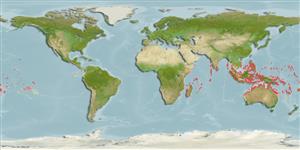>
Ovalentaria/misc (Various families in series Ovalentaria) >
Pomacentridae (Damselfishes) > Pomacentrinae
Etymology: Pomacentrus: Greek, poma, -atos = cover, operculum + Greek, kentron = sting (Ref. 45335).
More on author: Bloch.
Environment: milieu / climate zone / depth range / distribution range
पारिस्थितिकी
समुद्री प्रवाल-भित्ति संयुक्त; गैर प्रवासी; गहराई सीमा 1 - 18 m (Ref. 89972). Tropical; 16°N - 32°S
Indo-Pacific: East Africa to the Tuamoto Islands, north to Taiwan, south to Lord Howe Island.
आकार / वज़न / Age
Maturity: Lm ? range ? - ? cm
Max length : 8.5 cm SL पुल्लिंग / अलिंग; (Ref. 7247)
पृष्ठीय रीढ़ (सम्पूर्ण) : 13; पृष्ठीय सौफट रेज़ (सम्पूर्ण) : 13 - 14; गुदा कांटा: 2; ऐनल सौफट रेज़: 12 - 14.
Adults inhabit sandy areas of lagoon reefs, around isolated patch reefs, coral heads, or rubble. Usually in groups (Ref. 4391, 48636). Commonly found around jetty structures (Ref. 48636). Feed on zooplankton and filamentous algae (Ref. 7247). Diurnal species (Ref. 54980; 113699).
Life cycle and mating behavior
परिपक्व अवधि | पुनरुत्पत्ति | मछलीऔ का अंडे देना | अंडे | Fecundity | लार्वा
Oviparous, distinct pairing during breeding (Ref. 205). Eggs are demersal and adhere to the substrate (Ref. 205). Males guard and aerate the eggs (Ref. 205).
Allen, G.R., 1991. Damselfishes of the world. Mergus Publishers, Melle, Germany. 271 p. (Ref. 7247)
IUCN Red List Status (Ref. 130435: Version 2024-1)
Threat to humans
Harmless
Human uses
मात्स्यिकी: लघु वाणिज्य; जलजीवालय: सार्वजनिक लजीवालय
साधन
Special reports
Download XML
इंटरनेट स्रोत
Estimates based on models
Preferred temperature (Ref.
123201): 25.2 - 29.3, mean 28.5 °C (based on 2624 cells).
Phylogenetic diversity index (Ref.
82804): PD
50 = 0.5000 [Uniqueness, from 0.5 = low to 2.0 = high].
Bayesian length-weight: a=0.02089 (0.01313 - 0.03326), b=2.93 (2.79 - 3.07), in cm total length, based on LWR estimates for this species & Genus-body shape (Ref.
93245).
Trophic level (Ref.
69278): 3.0 ±0.24 se; based on food items.
लौटाव (Ref.
120179): ऊंचा, न्यूनतम जनसंख्या दुगनी समय अवलागत 15 महीने। (Preliminary K or Fecundity.).
Fishing Vulnerability (Ref.
59153): Low vulnerability (10 of 100).
Nutrients (Ref.
124155): Calcium = 131 [64, 221] mg/100g; Iron = 0.903 [0.518, 1.538] mg/100g; Protein = 18.1 [16.8, 19.3] %; Omega3 = 0.115 [0.063, 0.201] g/100g; Selenium = 19.8 [9.6, 41.9] μg/100g; VitaminA = 165 [46, 589] μg/100g; Zinc = 1.71 [1.10, 2.55] mg/100g (wet weight);
